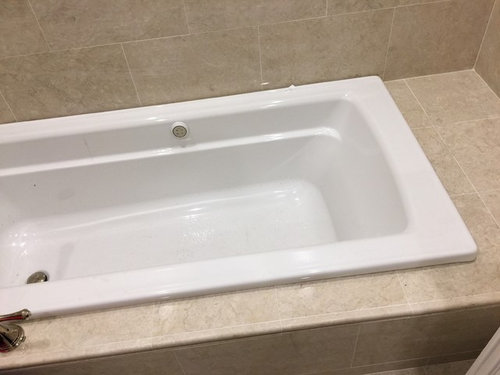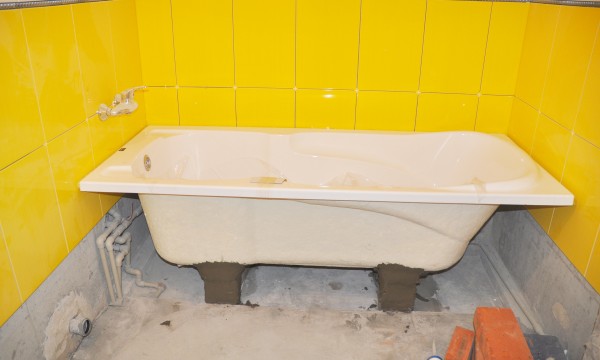DIY Tub Installation.
DIY Tub Installation.
Blog Article
The article listed below about How to Install a Bathtub is immensely stimulating. Have a go and draw your own assumptions.

Mounting a tub isn't specifically rocket science, but it does need strong plumbing, woodworking, and often, tiling abilities. Changing an old bathtub with a new one is likewise a reasonably hard project. If the old tub is easily obtainable, the task can move rapidly; if you have to open up a wall surface to get rid of the old bathtub and position the new tub, the job is a lot harder. In either instance, the task is within a home handyman's skills, although you will need a helper to leave the old bathtub and also embeded in the brand-new one. Make sure you have actually certified yourself for the job and are comfortable attempting it. Instead of employing a professional to take control of a halfway-completed job, it is much better to take into consideration using one prior to you start. Opportunities are you might require a specialist plumber to make tube links.
This write-up will assist you set up a new tub in your restroom if you have currently acquired a brand-new bathtub as well as don't need to change the setup of your previous water system pipelines.
Your tools as well as material checklist should comprise the following:
Preparing for the Installment
To start with, the sustaining framework supplied with the bath should be fitted (if required) according to the supplier's guidelines. Next, fit the taps or mixer to the bath tub. When suitable the faucet block, it is essential to ensure that if the tap features a plastic washing machine, it is fitted between the bath and also the faucets. On a plastic bath, it is also reasonable to fit a sustaining plate under the taps unit to stop pressure on the tub.
Fit the flexible faucet ports to the bottom of the two taps making use of 2 nuts as well as olives (in some cases provided with the bathtub). Fit the plug-hole outlet by smearing mastic filler round the sink electrical outlet hole, and afterwards pass the electrical outlet with the hole in the bath. Make use of the nut supplied by the manufacturer to fit the plug-hole. Check out the plug-hole outlet for an inlet on the side for the overflow pipe.
Next off, fit the end of the adaptable overflow pipeline to the overflow outlet. Afterwards, screw the pipe to the overflow face which should be fitted inside the bathroom. Ensure you make use of all of the supplied washing machines.
Connect the trap to the bottom of the waste electrical outlet on the bathtub by winding the string of the waste outlet with silicone mastic or PTFE tape, and screw on the catch to the outlet. Attach the bottom of the overflow tube in a comparable manner.The bath need to now prepare to be fitted in its last setting.
Removing Old Taps
If you require to replace old faucets with new ones as a part of your setup, then the first thing you must do is disconnect the water system. After doing so, turn on the faucets to drain any type of water continuing to be in the system. The process of getting rid of the existing taps can be fairly problematic because of the limited access that is commonly the case.
Utilize a container wrench (crowsfoot spanner) or a tap device to undo the nut that links the supply pipelines to the taps. Have a towel ready for the staying water that will certainly come from the pipelines. As soon as the supply pipes have actually been removed, utilize the very same tool to loosen the nut that holds the faucets onto the bath/basin. You will need to quit the solitary taps from transforming throughout this process. When the faucets have been eliminated, the holes in the bath/basin will certainly have to be cleaned of any type of old securing compound.
Before going on to fit the new taps, contrast the pipeline connections on the old taps to the brand-new faucets. If the old taps are longer than the new taps, after that a shank adapter is needed for the new taps to fit.
Setting up the Bath tub
Using the two wood boards under its feet, position the bath tub in the required setting. The wood boards are handy in evenly spreading the weight of the tub over the location of the boards as opposed to focusing all the weight onto four little factors.
The following objective is to ensure that the bathtub is leveled all round. This can be accomplished by inspecting the level and changing the feet on the bathtub up until the level reads level.
To install taps, fit all-time low of the outermost adaptable faucet adapter to the appropriate supply pipe by making a compression join; then do the exact same for the various other faucet.
Turn on the water system as well as check all joints and also brand-new pipework for leakages as well as tighten them if needed. Fill up the bathtub and also examine the overflow electrical outlet and also the regular electrical outlet for leaks.
Lastly, repair the bath paneling as defined in the supplier's user's manual. Tiling as well as sealing around the bathtub should wait till the bath tub has actually been used a minimum of once as this will resolve it right into its final position.
Suitable New Touches
If the tails of the new taps are plastic, after that you will certainly need a plastic connector to avoid damage to the thread. One end of the adapter fits on the plastic tail of the faucet and the various other end gives a connection to the existent supply pipelines.
If you require to fit a monobloc, then you will call for minimizing couplers, which connects the 10mm pipeline of the monobloc to the common 15mm supply pipe.
Next off, place the tap in the placing opening in the bath/basin guaranteeing that the washing machines are in place in between the faucet as well as the sink. Secure the faucet in position with the maker offered backnut. Once the faucet is safely in place, the supply pipelines can be attached to the tails of the taps. The taps can either be attached by utilizing corrugated copper piping or with normal faucet ports. The former type needs to be linked to the tap finishes first, tightening only by hand. The supply pipelines can later be linked to the various other end. Tighten up both ends with a spanner after both ends have actually been connected.
Tiling Around the Bathtub
In the area where the bathroom fulfills the floor tile, it is necessary to seal the joins with a silicone rubber caulking. This is very important as the installation can relocate sufficient to fracture an inflexible seal, causing the water to penetrate the wall surface in between the bathroom and the tiling, leading to complications with dampness and possible leaks to the ceiling below.
You can select from a range of coloured sealants to blend in your fixtures as well as installations. They are offered in tubes as well as cartridges, as well as can securing spaces as much as a size of 3mm (1/8 inch). If you have a bigger space to fill up, you can fill it with twists of soaked newspaper or soft rope. Keep in mind to always fill the bathtub with water before sealing, to allow for the movement experienced when the tub remains in usage. The sealer can split rather very early if you do not take into account this movement before sealing.
Alternatively, ceramic coving or quadrant tiles can be used to edge the bathroom or shower tray. Plastic strips of coving, which are easy to use and reduce to dimension, are likewise quickly offered on the market. It is advisable to fit the tiles making use of waterproof or water resistant sticky and grout.
Bathtub Installation
How Important Is A Bathtub To Your Home?
High-quality baths, showers, and other bathroom updates are necessary when considering a smart investment in your home. It’s a room that you go to every day and one that is constantly being used by guests.The bathroom is one of the top trafficked rooms in a home and also one of the most valuable in terms of home resale.
Install Piping Before Tub
You will be using your existing drain and waste vent system, but pipes required include the hot and cold water supply lines and a pipe leading to a shower head. A mixing valve and shower head are also needed. Air chambers may be required.
Position the Tub
Lower the tub into place so that the continuous flange fits against the wall studs and rests on 1’x4' or 2’x4' supports. Anchor the tub to the enclosure with nails or screws inserted through the flanges into the studs.
NOTE: Remember, bathtubs and shower stalls may require support framing. A bathtub filled with water is extremely heavy, so check building codes and framing support before installing the tub.
Assemble Drain Connections
Assemble the bathtub drain connections by connecting the tub overflow with the tub drain above the trap, not beyond it. The trap will have a compression fitting that screws over the arm of the overflow assembly.
Place a Pipe For the Shower Head
First, locate a brass female threaded winged fitting and attach it to a framing support via a screw or a nail. Then run a pipe up the wall for the shower head. Sweat or solder the other side of the brass fitting to the top of the pipe.
Attaching Hot and Cold Water Lines
Attach your water lines for both hot and cold by sweating these directly into the hot and cold ports of the mixing valve. The mixing valve will be how water enters the tub’s system, not by the pipes themselves.
Install the Spout
Extend a piece of 1/2 inch pipe, or whichever length is specified in the manufacturer’s instructions, for the tub spout. Sweat on a male threaded fitting at the end of the pipe or use a brass nipple of the proper length and a 1/2 inch cap.
NOTE: At this point you should have your rough-in plumbing work inspected before proceeding further.
Check For Leaks
Restore the water pressure and check the drain connection and the supply pipes for any sign of leaking.
estore the Bathroom Wall
Replace the wall with moisture-resistant drywall as a base for your wall covering. Seal the joints between the wall and your new tub with silicone caulk as protection against water seepage.
https://www.berkeys.com/2016/12/02/bathtub-installation-dallas/

Do you like reading up on A Step-by-Step Guide to Installing a Bathtub? Write feedback directly below. We'd be glad to hear your opinions about this post. Hoping to see you back again later on. Do you know somebody who is in the market for the topic? Feel free to promote it. Bless you for your time. Please visit our site back soon.
Need Help? Hire Us Now! Report this page